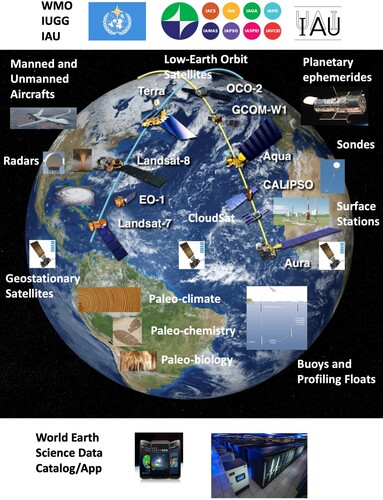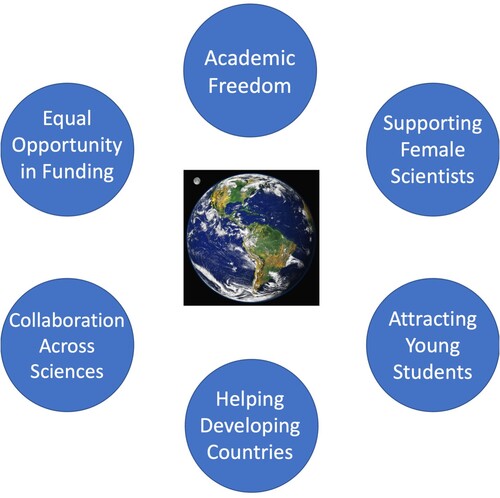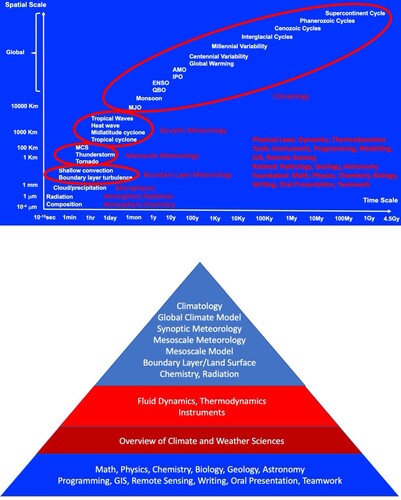ABSTRACT
This paper summarizes the current challenges in climate and weather research and provides suggestions for future research directions in global observing systems, in modelling and prediction, and in academic environment and education systems.
RÉSUMÉ
[Traduit par la rédaction] Le présent document résume les défis actuels de la recherche sur le climat et la météo, et propose des suggestions pour les orientations ultérieures de la recherche dans les systèmes d’observation mondiaux, dans la modélisation et les prévisions, et dans l’environnement universitaire et les systèmes d’éducation.
Humankind has already gone through a long journey in observing, understanding and predicting Earth’s weather and climate. The first international network of meteorological observations, the Medici Network, was implemented in Europe in 1654 and was in operation for sixteen years (Camuffo & Bertolin, Citation2012). Regular weather observations were started by the Royal Society in the UK in 1744 and the telegraphic daily weather report began in 1849. Upper air radiosondes were invented in the 1930s, while meteorological radar and aircraft reconnaissance started in the 1940s during and just after World War II. The first meteorological satellite was launched in 1960. Today we have a comprehensive global meteorological network of observations including satellites, radars, upper air sounding stations and surface stations (see review by Bluestein et al., Citation2022 in this special issue). Observations of ocean tides and global sea level began in the mid-seventeenth century, and self-registering tide gauges were invented in the 1830s. In 1853, ten countries reached agreement on a code of observational practice at sea. Observations of ocean subsurface temperature began with reversing thermometers in 1878. Today we have established a global ocean observing system with satellites, ships, buoys, drifters and coastal stations (Davis et al., Citation2019). Paleoclimatology began in the seventeenth century when the basic principles of stratigraphy were established. Radioisotopic dating and modern techniques of mass spectrometry were devised in the early twentieth century and have been applied to numerous paleoclimate proxies, such as tree rings, coral reefs, lake sediments, speleothems, ice cores, ocean sediments, paleosols and rocks. We now have developed solid regional paleoclimate field reconstructions and global paleoclimate reanalysis, and we are studying the Earth’s climate variability over the past 4.5 billion years of Earth history.
Geophysical fluid dynamics was founded by Laplace who published the famous Laplace equations of tidal dynamics in the late eighteenth century (Laplace, Citation1775, Citation1798). The Navier-Stokes equations were formulated in the nineteenth century (Navier, Citation1822; Stokes, Citation1842). The complete primitive equations were published by Poincare (Citation1901), Abbe (Citation1901) and V. Bjerknes (Citation1904), and were later applied to theoretical atmospheric models (J. Bjerknes, Citation1937; Charney, Citation1948; Eliassen, Citation1949; Rossby, Citation1939, Citation1940), theoretical ocean models (Ekman, Citation1905; Munk, Citation1950; Stommel, Citation1948; Sverdrup, Citation1947), theoretical mantle models (Davies, Citation1977; Morgan, Citation1972; Pekeris, Citation1935; Runcorn, Citation1962) and theoretical core geodynamo models (Backus, Citation1958; Herzenberg, Citation1958; Larmor, Citation1919). After modern electronic digital computers were invented in the 1940s, numerical models have been developed based on the primitive equations for Earth’s atmosphere, ocean, mantle and core geodynamo. We now have Earth system models coupling the atmosphere, ocean, land, sea ice and biogeochemistry cycles (see review by Randall et al., Citation2019), and we are improving key physical processes such as atmospheric convection (see review by Lin & Qian, Citation2022a in this special issue) and cloud microphysics (see review by Seiki et al., Citation2022 in this special issue).
Using comprehensive observing systems and powerful theoretical and numerical models, we have made great progress in describing and understanding the dominant modes of climate variability and disastrous climate and weather extremes of the Earth system (). This special issue covers the dominant modes of climate variability such as the supercontinent cycle and the Phanerozoic cycles (see review by Lin & Qian, Citation2022b in this special issue), the interglacial cycles and millennial variability (see review by Ditlevsen, Citation2022 in this special issue), the Atlantic Multi-decadal Oscillation (see review by Lin & Qian, 2022 in this special issue), and the Madden-Julian Oscillation (see review by H. Lin, Citation2022 in this special issue), as well as the disastrous extremes such as droughts and mega-droughts (see review by Lin, Qian and Schubert Citation2022 in this special issue), tropical cyclones (see review by Lin, Qian and Klotzbach Citation2022 in this special issue), and tornadoes and tornado outbreaks (see review by Tochimoto, Citation2022 in this special issue).
Despite our substantial progress, we are still facing significant challenges in understanding and predicting Earth’s climate and weather, because the Earth’s climate system is a complex system with global teleconnections among different regions, and strong feedbacks among its different components, such as the atmosphere, ocean, land, sea ice and biogeochemistry. The greatest challenges are:
What is the primary driver of the supercontinent cycle?
What is the primary driver of the 100,000-year interglacial cycle?
What is the primary driver of the millennial-scale variability?
What is the primary driver of the centennial-scale variability? What are the relative roles of anthropogenic global warming and natural variability in generating the ongoing global climate change?
What is the primary driver of the Atlantic Multi-decadal Oscillation? What are the relative roles of AMOC, stochastic forcing and other potential factors in generating the AMO and the above longer-scale variability?
What causes the switch between El Niño and La Niña?
What is the primary driver of the Madden-Julian Oscillation?
What are the relative roles of SST-driven teleconnections, inter-basin interactions, atmospheric internal dynamics, local feedbacks, cross-timescale interactions and other potential factors in generating the continental droughts and other climate impacts?
What are the primary mechanisms of the stratosphere-troposphere coupling and the teleconnections involving the stratosphere?
What is the primary driver of the rapid intensification of tropical cyclones?
What is the primary driver of the explosive cyclogenesis in the extratropics?
What determines the timing, location and intensity of the deadliest tornadoes?
How does the evolution of the whole Earth system (atmosphere, hydrosphere, mantle, core) affect the surface climate?
How does the solar system affect Earth’s climate through the variations of radiative flux, high energy particles and tidal gravitational force?
To overcome these challenges, international collaborations across different sciences are needed. The American Meteorological Society (AMS), the American Geophysical Union (AGU), the International Union of Geodesy and Geophysics (IUGG), and the International Astronomical Union (IAU) were all founded in 1919. On their 100-year anniversary, they published their strategic plan for the future (AGU, Citation2020; AMS Council, Citation2020; IAU, Citation2018; Joselyn et al., Citation2019). The World Meteorological Organization (WMO) published Vision for the WMO Integrated Global Observing System in 2040 (WMO, Citation2019), while the World Climate Research Programme (WCRP) released its strategic plan for the next decade (WCRP, Citation2019). The European Union announced the plan for Copernicus – the European Earth Observation programme (Jutz & Milagro-Pérez, Citation2020; Thepaut et al., Citation2018). The U.S. National Research Council published a series of reports on the future of the individual fields of the atmospheric sciences (NAS, Citation2016a, Citation2016b, Citation2017, Citation2018a, Citation2018b).
Based on these reports and our reviews in this special issue, we suggest the following directions for future observations of Earth’s climate system ():
Improve the spatial coverage and spatiotemporal resolution of the backbone global observation system (). We suggest to increase the spatial resolution of the geostationary satellites and low-Earth orbit satellites to about 100 m ((a)), fill the gaps between land surface stations using automated surface weather stations ((b)), fill the gaps in upper air sounding stations using automated balloon-sounding system launched from moored buoys ((c)), fill the gaps and commercially-induced decrease in ship-based ocean surface observations using moored and drifting buoys and uncrewed surface vehicles ((d)), and increase the depth of deep ocean profiling floats ((e)).
Develop a global unmanned aircraft network for studying tropical cyclones, severe storms and tornadoes. Drones carrying remote-sensing and flight-level instruments can be used to fly above and inside these deep convective systems, which can provide valuable research datasets as well as in-situ monitoring and accurate short-term warning.
Improve very-high-resolution instruments for studying tornadoes, such as satellites, radars and lidars. We suggest developing very-high-resolution satellites with 1–10 m resolution specifically for observing cloud-top structure associated with tornadoes (Adler & Fenn, Citation1981; Marion et al., Citation2019; Sandmæl et al., Citation2019).
Develop very-high-resolution reanalysis such as global storm-scale (1 km) reanalysis and regional tornado-resolving (1–10 m) reanalysis. The very-high-resolution observations listed above will provide the foundation for such reanalysis, while non-hydrostatic global and regional models will be needed for the data assimilation.
Expand the paleoclimate proxies archive and improve the dating methods. We suggest to fill the gaps in the global tree-ring network ((a)), the global coral network ((b)), the global speleothem network ((c)), the global ice core network ((d)), and the global ocean sediment network ((e)). We suggest conducting inter-calibrations within each network as well as among different networks. We suggest to re-date the paleoclimate proxies using the annual layer counting method whenever possible, and improve the dating methods when annual layer counting is not feasible. We need to significantly expand the paleoclimate proxies archive for the past 65 million years (Cenozoic), the past 541 million years (Phanerozoic), and the past 4.5 billion years (Precambrian).
Develop regional paleoclimate field reconstructions and global paleoclimate reanalysis. We suggest expanding the paleoclimate field reconstructions for regions with the best data availability. We suggest expanding the paleo-atmospheric reanalysis for the past 2000 years to the upper air and restore the decadal-centennial variability from the raw data. We suggest developing paleo-ocean reanalysis for the past 2000 years, paleoclimate reanalysis for the past 15,000 years (Holocene), paleoclimate reanalysis for the past 110,000 years (Last Glacial Maximum), paleoclimate reanalysis for the past one million years (Late-Quaternary), and paleoclimate reanalysis for the past 65 million years (Cenozoic), all with reconstructions of paleo-cryosphere especially sea ice history.
Enhance research on paleo-chemistry, especially the evolution of CO2 in the Earth’s climate history, and on paleo-biology, especially changes in biodiversity in the Earth’s climate history. Enhance research on paleo-forcing, especially the planetary ephemerides. We need to develop different CO2 proxies and conduct intercomparisons among the different proxies. We suggest collecting more proxies for paleo-rotation which serve as the observational benchmark for planetary ephemerides. We need to extend the length of planetary ephemerides back to 4.5 billion years ago. We need to collect more paleo proxies for solar activity and geomagnetic intensity.
Develop WMO/IUGG/IAU catalog/app for all weather and climate datasets around the world and promote data accessibility in all countries’ data centres. All peer-reviewed publications should make their data accessible. All data centres are encouraged to use international data format, such as Excel and NetCDF.
Fig. 3 Current status of the backbone global observation system. (A) Satellite – the European Copernicus Sentinel programme (from NAS Citation2018a). (B) Land surface – Global Land Surface Databank Stations (courtesy of NOAA NCEI). (C) Upper air sounding stations (courtesy of NOAA NWS). (D) Ocean surface – the ICOADS observations for August 2021 (courtesy of NOAA). (E) Deep ocean – the Argo profiling floats for September 28, 2021 (from Argo Programme).
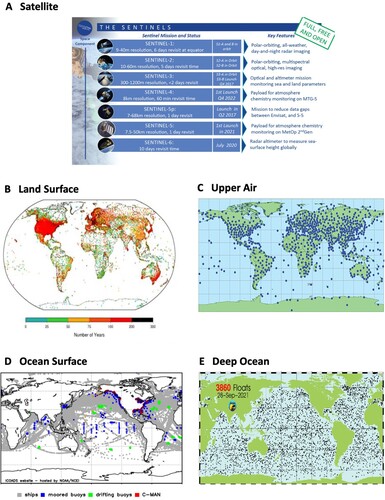
Fig. 4 Current status of the paleoclimate proxy networks. (A) Tree ring (Locosselli et al., Citation2020). (B) Coral (Tierney et al., Citation2015). (C) Speleothem (Comas-Bru et al., Citation2020). (D) Ice core (Jouzel, Citation2013 and the OSU Ice Core Group). (E) Ocean sediment (National Research Council, Citation2011).
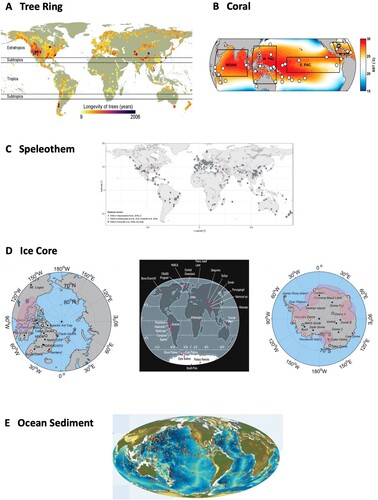
With the limited funding and resources, items (1), (2), (4), (5) and (6) are of the highest priority. We suggest the following directions for future modelling and prediction of Earth’s weather and climate ():
For weather prediction, we suggest developing high-resolution (0.1–1 km) tropical cyclone forecast models which can clearly resolve a tropical cyclone’s central eye, and very-high-resolution (1–10 m) nested-grid tornado forecasting models, and studying interactions between vortex dynamics and the stratosphere. Current computation power allows ensemble predictions using multiple nested grids with 50-m resolution on the inner-most grids (Mashiko, Citation2016; Snook et al., Citation2019; Xue et al., Citation2014; Yokota et al., Citation2018). The very-high-resolution observations and reanalysis products listed above will provide the initial fields and verifications.
For climate prediction, we suggest developing Earth system models with a full representation of the stratosphere and a high-resolution ocean component that can clearly resolve the thermocline in the vertical direction and eddies and tides in the horizontal direction, and which includes tidal forcing from the solar system. Current computation power allows 1/12° or finer grids for the global ocean models.
For studying Earth’s climate variability over the past 4.5 billion years, we suggest developing a Whole Earth model combining the atmosphere, hydrosphere and lithosphere, all of which are rotating convective fluids governed by the primitive equations and driven by external radiative forcing and gravitational forcing from the solar system.
Fig. 5 Schematic of future integrated research on modelling and predictions of Earth’s climate and weather.
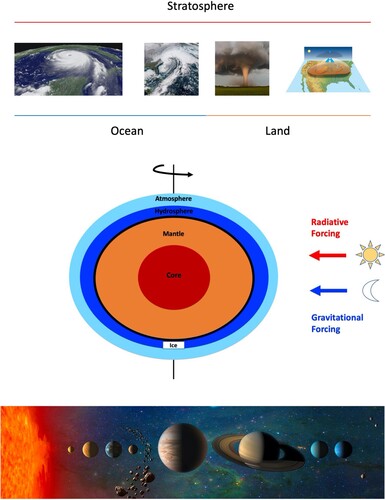
To overcome the current challenges, we need a supportive and collaborative environment for scientific research with emphasis on ():
Academic freedom. Open-minded independent thinking is the key to important scientific discovery. We should encourage explorations of new directions and new ideas and use the peer-review process to guarantee the quality of the work.
Equal opportunity in funding. We call for equal opportunity in funding on natural climate variability, extreme weather events and human-induced climate change. We call for small-size seed funding for early-career scientists, medium-size funding for individual explorations, and caution regarding large-size funding that is often spent on infrastructure and administrative support.
Supporting female scientists. Despite some improvements, female scientists continue to face discrimination, unequal pay, and funding disparities (Gay-Antaki & Liverman, Citation2018). Women face barriers associated with their family responsibilities and are poorly represented in journals and citations (Ceci & Williams, Citation2011). Including women in research teams strongly enhances innovation and discovery. Despite the low female representation in Mathematics and Statistics, Engineering, and Physics and Astronomy, top women scholars in those three fields conduct more impactful research than their male colleagues (Chan & Torgler, Citation2020).
Collaborations across sciences. It is important to have collaborations among atmospheric science, oceanography, geology, astronomy, chemistry, biology and other sciences related to Earth’s climate system, and among the WMO, IUGG, IAU and their member organizations.
Helping developing countries. Many developing countries lack the experts and resources for weather and climate research, modelling and, most importantly, prediction. We suggest that the WMO could organize international collaborations in disaster predictions, such as a drought prediction bulletin similar to the existing ENSO prediction bulletin, which could help the developing countries and save the lives of many people. Another example is the extremely deadly cyclones in the North Indian Ocean. The deadliest tropical cyclones of the past 40 years, Cyclone 02B in 1991 and Cyclone Nargis in 2008, both resulting in ∼130,000 fatalities, occurred in the North Indian Ocean. Unfortunately, research on cyclones in this region is very limited. There is an urgent need for in-depth research to help save lives in this highly populated region.
Attracting young students. New blood is most important for the future progress of climate and weather research, modelling and prediction. We need to attract talented students from different majors such as math, physics, chemistry, biology and engineering. Introducing atmospheric dynamics/physics/chemistry classes at junior and senior levels for physics, math, and chemistry majors may help to better attract talent from these fields.
The quality of education for the new students will strongly affect the level of research in the future. WMO (Citation2015) provided an excellent guide to education and training standards in Meteorology, while Mosher and Keane (Citation2021) offered a far-reaching vision for the future of undergraduate Geoscience education. For the prosperity of climate and weather research in the future, a successful education programme should emphasize ():
The spirit of academic freedom, independent thinking, diversity and equal opportunity.
Integration of atmospheric science, oceanography, geology, astronomy and other sciences related to Earth’s climate system.
Systematic training in climate and weather sciences on fluid dynamics, thermodynamics and instruments, as well as atmospheric chemistry, atmospheric radiation, microphysics, boundary layer meteorology, mesoscale meteorology, synoptic meteorology and climatology.
Solid skills in computer programming, writing and oral presentation. The undergraduate students in atmospheric sciences now generally lack solid skill in computer programming, which prevents them from participating in real research work although most of them have a strong interest in weather and climate. Early training of computer programming from high school is highly recommended.
In 1900 Lord Kelvin gave the famous lecture Nineteenth-Century Clouds over the Dynamical Theory of Heat and Light pointing to two “dark clouds” hanging over physics at that time, which eventually led to the discovery of the theory of relativity and quantum mechanics, respectively. Here we have listed the biggest current challenges in climate and weather sciences, which hopefully can be overcome in the next 30–50 years. Climate and weather scientists are like detectives who have in hand only a limited number of samples from the crime scene, some having been degraded by time, from which they try to figure out what really happened. It is a very difficult job, but it is a lot of fun. As Galileo Galilei said:
Facts which at first seem improbable will, even on scant explanation, drop the cloak which has hidden them and stand forth in naked and simple beauty.
Acknowledgements
Jialin Lin thanks Damian Nance for editing of an earlier version of the manuscript.
Disclosure statement
No potential conflict of interest was reported by the author(s).
References
- Abbe, C. (1901). The physical basis of long-range weather forecasts. Monthly Weather Review, 29(12), 551–561. https://doi.org/10.1175/1520-0493(1901)29[551c:TPBOLW]2.0.CO;2
- Adler, R. F., & Fenn, D. D. (1981). Satellite-observed cloud-top height changes in tornadic thunderstorms. Journal of Applied Meteorology, 20(11), 1369–1375. https://doi.org/10.1175/1520-0450(1981)020<1369:SOCTHC>2.0.CO;2
- AGU. (2020). AGU strategic plan. https://news.agu.org/files/2020/05/Final_AGU_Strategic_Plan_2020_Final.pdf
- AMS Council. (2020). Priorities for a new decade: Weather, water, and climate – a policy statement of the American Meteorological Society.
- Backus, G. (1958). A class of self-sustaining dissipative spherical dynamos. Annals of Physics, 4(4), 372–447. https://doi.org/10.1016/0003-4916(58)90054-X
- Bjerknes, J. (1937). Die Theorie der aussertropischen Zyklonenbildung. Meteorologische Zeitschrift, 54, 460–466.
- Bjerknes, V. (1904). Das Problem der Wettervorhersage, betrachtet vom Standpunkt der Mechanik und der Physik. Meteorologische Zeitschrift, 21, 1–7.
- Bluestein, H. B., Carr, F. H., & Goodman, S. J. (2022). Atmospheric observations of weather and climate. Atmosphere-Ocean, Advance online publication.
- Camuffo, D., & Bertolin, C. (2012). The earliest temperature observations in the world: The Medici Network (1654–1670). Climatic Change, 111(2), 335–363. https://doi.org/10.1007/s10584-011-0142-5
- Ceci, S. J., & Williams, W. M. (2011). Understanding current causes of women's underrepresentation in science. Proceedings of the National Academy of Sciences, 108(8), 3157–3162. https://doi.org/10.1073/pnas.1014871108
- Chan, H. F., & Torgler, B. (2020). Gender differences in performance of top cited scientists by field and country. Scientometrics, 125(3), 2421–2447. https://doi.org/10.1007/s11192-020-03733-w
- Charney, J. G. (1948). On the scale of atmospheric motions. Journal of Meteorology, 4, 135–163. https://link.springer.com/chapter/10. 1007/978-1-944970-35-2_14?noAccess=true
- Comas-Bru, L., Rehfeld, K., Roesch, C., Amirnezhad-Mozhdehi, S., Harrison, S. P., Atsawawaranunt, K., Ahmad, S. M., Brahim, Y. A., Baker, A., Bosomworth, M., Breitenbach, S. F. M., Burstyn, Y., Columbu, A., Deininger, M., Demény, A., Dixon, B., Fohlmeister, J., Hatvani, I. G., Hu, J., … Zhang, H. (2020). SISALv2: A comprehensive speleothem isotope database with multiple age-depth models. Earth System Science Data, 12(4), 2579–2606. https://doi.org/10.5194/essd-12-2579-2020
- Davies, G. F. (1977). Whole-mantle convection and plate tectonics. Geophysical Journal International, 49(2), 459–486. https://doi.org/10.1111/j.1365-246X.1977.tb03717.x
- Davis R. E., et al. (2019). 100 Years of Progress in Ocean Observing Systems. In Greg McFarquhar (Ed.), A Century of Progress in Atmospheric and Related Sciences. https://doi.org/10.1175/AMSMONOGRAPHS-D-18-0014.1
- Ditlevsen, P. (2022). The pleistocene glacial cycles and millennial scale climate variability. Atmospheric observations of weather and climate. Atmosphere-Ocean, Advance online publication.
- Ekman, V. W. (1905). On the influence of the earth's rotation on ocean-currents. Arkiv for Matematik, Astronomi och Fysik, 2(11), 52 pp. https://jscholarship.library.jhu.edu/bitstream/handle/1774.2/33989/31151027498728.pdf
- Eliassen, A. (1949). The quasi-static equations of motion with pressure as independent variable. Geofysiske Publikasjoner, 17(3), 1–44. Utgitt av Det Norske Videnskaps-Akademi, Oslo.
- Gay-Antaki, M., & Liverman, D. (2018). Climate for women in climate science: Women scientists and the intergovernmental panel on climate change. Proceedings of the National Academy of Sciences, 115(9), 2060–2065. https://doi.org/10.1073/pnas.1710271115
- Herzenberg, A. (1958). Geomagnetic dynamos. Philosophical Transactions of the Royal Society of London. Series A, Mathematical and Physical Sciences, 250(986), 543–583. https://doi.org/10.1098/rsta.1958.0007
- IAU. (2018). IAU Strategic Plan 2020–2030. https://www.iau.org/static/administration/about/strategic_plan/strategicplan-2020-2030.pdf
- Joselyn, J. A., Ismail-Zadeh, A., Beer, T., Gupta, H., Kono, M., Shamir, U., Sideris, M., & Whaler, K. (2019). IUGG in the 21st century. History of Geo- and Space Sciences, 10(1), 73–95. https://doi.org/10.5194/hgss-10-73-2019
- Jouzel, J. (2013). A brief history of ice core science over the last 50 yr. Climate of the Past, 9(6), 2525–2547. https://doi.org/10.5194/cp-9-2525-2013
- Jutz, S., & Milagro-PÈrez, M. P. (2020). Copernicus: The European Earth Observation programme. Revista de TeledetecciÛn (56).
- Laplace, P. S. (1775). Recherches sur Quelques Points de Systeme du Monde. Mem. Acad. Roy. Sci, 88.
- Laplace, P.-S. (1798). Traite de mecanique celeste, vol. 1, 368 pp., Crapelet, Paris.
- Larmor, J. (1919). How could a rotating body such as the Sun become a magnet? Report of the British Association for the Advance of Science, 87, 159–160.
- Lin, H. (2022). The Madden-Julian oscillation. Atmospheric Observations of Weather and Climate. Atmosphere-Ocean, Advance online publication.
- Lin, J. L., & Qian, T. (2022a). The Atlantic multi-decadal oscillation. Atmospheric Observations of Weather and Climate. Atmosphere-Ocean, Advance online publication.
- Lin, J. L., & Qian, T. (2022b). Earth’s climate history from 4.6 billion years to one minute. Atmospheric Observations of Weather and Climate. Atmosphere-Ocean, Advance online publication.
- Lin, J. L., Qian, T., & Klotzbach, P. (2022). Tropical cyclones. Atmospheric Observations of Weather and Climate. Atmosphere-Ocean, Advance online publication.
- Lin, J. L., Qian, T., & Schubert, S. D. (2022). Droughts and mega-droughts. Atmospheric Observations of Weather and Climate. Atmosphere-Ocean, Advance online publication.
- Locosselli, G. M., Brienen, R. J. W., Leite, M. d. S., Gloor, M., Krottenthaler, S., Oliveira, A. A. d., Barichivich, J., Anhuf, D., Ceccantini, G., Schöngart, J., & Buckeridge, M. (2020). Global tree-ring analysis reveals rapid decrease in tropical tree longevity with temperature. Proceedings of the National Academy of Sciences, 117(52), 33358. https://doi.org/10.1073/pnas.2003873117
- Marion, G. R., Trapp, R. J., & Nesbitt, S. W. (2019). Using overshooting top area to discriminate potential for large, intense tornadoes. Geophysical Research Letters, 46(21), https://doi.org/10.1029/2019GL084099
- Mashiko, W. (2016). A numerical study of the 6 May 2012 Tsukuba City supercell tornado. Part II: Mechanisms of tornadogenesis. Monthly Weather Review, 144(9), 3077–3098. https://doi.org/10.1175/MWR-D-15-0122.1
- Morgan, W. J. (1972). Deep mantle convection plumes and plate motions. AAPG Bulletin, 56, 203–213. https://doi.org/10.1306/819A3E50-16C5-11D7-8645000102C1865D
- Mosher, S., & Keane, C. (Eds.). (2021). Vision and change in the geosciences: The future of undergraduate geoscience education. American Geosciences Institute.
- Munk, W. H. (1950). On the wind driven ocean circulation. Journal of Meteorology, 7, 79–93. https://doi.org/10.1175/1520-0469(1950)007<0080:OTWDOC>2.0.CO;2
- NAS. (2016a). Next generation earth system prediction: Strategies for subseasonal to seasonal forecasts. The National Academies Press. https://doi.org/10.17226/21873
- NAS. (2016b). The future of atmospheric chemistry research: Remembering yesterday, understanding today, anticipating tomorrow. The National Academies Press. https://doi.org/10.17226/23573
- NAS. (2017). Sustaining ocean observations to understand future changes in earth's climate. The National Academies Press. https://doi.org/10.17226/24919
- NAS. (2018a). Thriving on our changing planet: A decadal strategy for earth observation from space. The National Academies Press. https://doi.org/10.17226/24938
- NAS. (2018b). The future of atmospheric boundary layer observing, understanding, and modeling: Proceedings of a workshop. The National Academies Press. https://doi.org/10.17226/25138
- National Research Council. (2011). Scientific ocean drilling: Accomplishments and challenges. National Academies Press. 145 p.
- Navier, C. L. M. H. (1822). On the laws of motion of fluids taking into consideration the adhesion of the molecules. Ann. Chim. Phys, 19, 234–245.
- Pekeris, C. (1935). Thermal convection in the interior of the earth, Monthly Notices Roy. Astron. Soc., Geophys. Suppl, 3, 343–367. https://doi.org/10.1111/j.1365-246X.1935.tb01742.x
- Poincare, H. (1901). Sur une forme nouvelle des equations de la m echanique. CR Acad. Sci., 132, 369–371.
- Randall, D. A., Bitz, C. M., Danabasoglu, G., Denning, A. S., Gent, P. R., Gettelman, A., Griffies, S. M., Lynch, P., Morrison, H., Pincus, R., & Thuburn, J. (2019). 100 years of Earth system model development. Meteorological Monographs, 59, 12.1–12.66. https://doi.org/10.1175/AMSMONOGRAPHS-D-18-0018.1
- Rossby, C. G. (1939). Relation between variations in the intensity of the zonal circulation of the atmosphere and the displacements of the semi-permanent centers of action. Journal of Marine Research, 2(1), 38–55. https://doi.org/10.1357/002224039806649023
- Rossby, C. G. (1940). Planetary flow patterns in the atmosphere. Quarterly Journal of the Royal Meteorological Society, 66(Suppl.), 68–87.
- Runcorn, S. (1962). Towards a theory of continental drift. Nature, 193(4813), 311–314. https://doi.org/10.1038/193311a0
- Sandmæl, T. N., Homeyer, C. R., Bedka, K. M., Apke, J. M., Mecikalski, J. R., & Khlopenkov, K. (2019). Evaluating the ability of remote sensing observations to identify significantly severe and potentially tornadic storms. Journal of Applied Meteorology and Climatology, 58(12), 2569–2590. https://doi.org/10.1175/JAMC-D-18-0241.1
- Seiki, T., Roh, W., & Satoh, M. (2022). Cloud microphysics in global cloud-resolving models. Atmospheric Observations of Weather and Climate. Atmosphere-Ocean. Advance online publication.
- Snook, N., Xue, M., & Jung, Y. (2019). Tornado-resolving ensemble and probabilistic predictions of the 20 May 2013 Newcastle–Moore EF5 tornado. Monthly Weather Review, 147(4), 1215–1235. https://doi.org/10.1175/MWR-D-18-0236.1
- Stokes, G. G. (1842). On the steady motion of incompressible fluids. Transactions of the Cambridge Philosophical Society, 7, 439–453.
- Stommel, H. (1948). The westward intensification of wind-driven ocean currents. Eos, Transactions American Geophysical Union, 29(2), 202–206. https://doi.org/10.1029/TR029i002p00202
- Sverdrup, H. U. (1947). Wind-driven currents in a baroclinic ocean; with application to the equatorial currents of the eastern Pacific. Proceedings of the National Academy of Sciences, 33(11), 318–326. https://doi.org/10.1073/pnas.33.11.318
- Thepaut, J.-N., Dee, D., Engelen, R., & Pinty, B. (2018). The Copernicus programme and its climate change service. In IGARSS 2018 – 2018 IEEE International Geoscience and Remote Sensing Symposium (pp. 1591–1593.ou).
- Tierney, J. E., Abram, N. J., Anchukaitis, K. J., Evans, M. N., Giry, C., Kilbourne, K. H., Saenger, C. P., Wu, H. C., & Zinke, J. (2015). Tropical sea surface temperatures for the past four centuries reconstructed from coral archives. Paleoceanography, 30(3), 226–252. https://doi.org/10.1002/2014PA002717
- Tochimoto, E. (2022). Environmental controls of Tornadoes and Tornado Outbreaks. Atmospheric Observations of Weather and Climate. Atmosphere-Ocean. Advance online publication.
- WCRP. (2019). World Climate Research Programme Strategic Plan 2019–2028. WCRP Publication 1/2019, 28 pp., https://www.wcrp-climate.org/wcrp-sp
- WMO. (2015). Guide to the Implementation of Education and Training Standards in Meteorology and Hydrology. Vol. 1 – Meteorology. WMO-No. 1083.
- WMO. (2019). Vision for the WMO Integrated Global Observing System in 2040. WMO-No. 1243.
- Xue, M., Hu, M., & Schenkman, A. D. (2014). Numerical prediction of the 8 May 2003 Oklahoma City tornadic supercell and embedded tornado using ARPS with the assimilation of WSR-88D data. Weather and Forecasting, 29(1), 39–62. https://doi.org/10.1175/WAF-D-13-00029.1
- Yokota, S., Niino, H., Seko, H., Kunii, M., & Yamauchi, H. (2018). Important factors for tornadogenesis as revealed by highresolution ensemble forecasts of the Tsukuba supercell tornado of 6 May 2012 in Japan. Monthly Weather Review, 146(4), 1109–1132. https://doi.org/10.1175/MWR-D-17-0254.1


